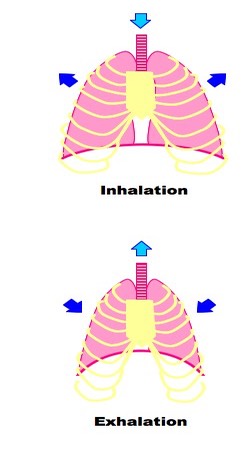6.4.1 Distinguish between ventilation, gas exchange and cell respiration
Respiration is the transport of oxygen to cells where energy production takes place, and involves three key processes:
- Ventilation: The exchange of air between the lungs and the atmosphere; it is achieved by the physical act of breathing
- Gas exchange: The exchange of oxygen and carbon dioxide in the alveoli and the bloodstream; it occurs passively via diffusion
- Cell Respiration: The release of ATP from organic molecules; it is greatly enhanced by the presence of oxygen (aerobic respiration)
6.4.2 Explain the need for a ventilation system
- Because gas exchange is a passive process, a ventilation system is needed to maintain a concentration gradient within the alveoli
- Oxygen is needed by cells to make ATP via aerobic respiration, while carbon dioxide is a waste product of this process and must be removed
- Therefore, oxygen must diffuse from the lungs into the blood, while carbon dioxide must diffuse from the blood into the lungs
- This requires a high concentration of oxygen - and a low concentration of carbon dioxide - in the lungs
- A ventilation system maintains this concentration gradient by continually cycling the air in the lungs with the atmosphere
6.4.3 Describe the features of alveoli that adapt them to gas exchange
Thin wall: Made of a single layer of flattened cells so that diffusion distance is small
Rich capillary network: Alveoli are covered by a dense network of capillaries that help to maintain a concentration gradient
Increased SA:Vol ratio: High numbers of spherically-shaped alveoli optimise surface area for gas exchange (600 million alveoli = 80 m2)
Moist: Some cells in the lining secrete fluid to allow gases to dissolve and to prevent alveoli from collapsing (through cohesion)
6.4.4 Draw an label a diagram of the ventilation system, including trachea, lungs, bronchi, bronchioles and alveoli
The Human Ventilation System

6.4.5 Explain the mechanism of ventilation of the lungs in terms of volume and pressure changes caused by the internal and external intercostal muscles, the diaphragm and abdominal muscles
- Breathing is the active movement of respiratory muscles that enable the passage of air to and from the lungs
- The mechanism of breathing is described as negative pressure breathing as it is driven by the creation of a negative pressure vacuum within the lungs, according to Boyle's Law (pressure is inversely proportional to volume)

Inspiration
- Diaphragm muscles contract and flatten downwards
- External intercostal muscles contract, pulling ribs upwards and outwards
- This increases the volume of the thoracic cavity (and therefore lung volume)
- The pressure of air in the lungs is decreased below atmospheric pressure
- Air flows into the lungs to equalise the pressure
Expiration
- Diaphragm muscles relax and diphragm curves upwards
- Abdominal muscles contract, pushing diaphragm upwards
- External intercostal muscles relax, allowing the ribs to fall
- Internal intercostal muscles contract, pulling ribs downwards
- This decreases the volume of the thoracic cavity (and therefore lung volume)
- The pressure of air in the lungs is increased above atmospheric pressure
- Air flows out of the lungs to equalise the pressure